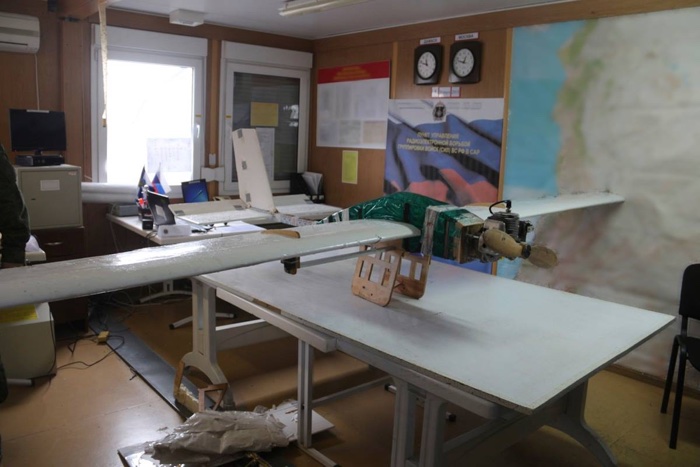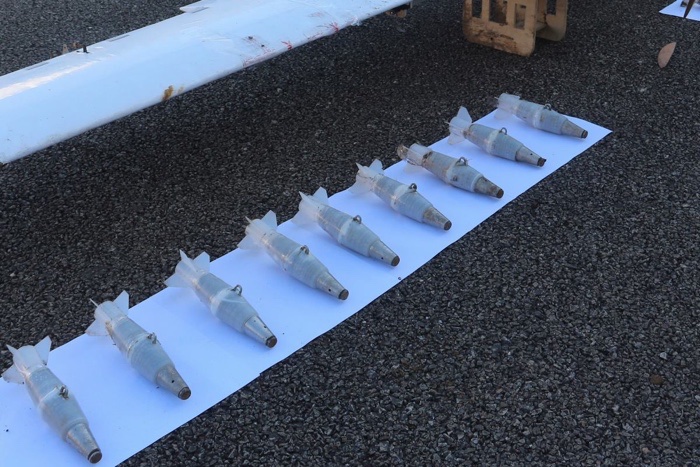"We
Know Who They Are": Putin Claims "State Provocateur"
Behind "Terrorist Drones" In Syria
12
January, 2018
Russian
President Vladimir Putin slammed those behind the massive drone
attack on Russia's two Syrian bases which took place on January 6,
saying in front of a large Russian media conference Thursday, "There
were some provocateurs, but they were not Turks. We know who they
are, who paid who for this provocation and what the actual sum was."
Meanwhile the Turkish newspaper Daily
Sabah reportsthat
Putin has privately informed Turkey's President Recep Tayyip Erdoğan
of which "provocateur" was behind a drone attack.
Earlier
this week we reported that the Russian military in
Syria thwarted
the highly coordinated attack on
Khmeimim air base and the Russian Naval facility in the city of
Tartus, intercepting 13 heavily armed UAVs launched by terrorists.
And underreported in international media was also a
prior New Year's Eve attack carried
out by a small squad of insurgents armed with mortars who were able
to kill two Russian servicemen while damaging up to seven aircraft at
Khmeimim Airbase, which constituted the single largest loss of
Russian military hardware throughout the Syria campaign.
Though
both attacks would appear to be merely the work of Islamist rebel
factions occupying nearby Idlib, multiple
extraordinary factors led the Russian Ministry of Defense to
immediately state that the perpetrators must
have had outside state sponsorship. First
there was - as the Russian Ministry of Defense mentioned in an early
media statement - "strange coincidences" surrounding the
terrorist attack: these included a US spy plane spotted in the area,
namely a US Navy’s Boeing P-8 Poseidon reconnaissance aircraft on
patrol between the Khmeimim airbase and Tartus naval base in Syria
during the time of the attack.
Secondly,
the airbase lies deep within Syrian regime territory in what is among
the most secure areas in all of Syria, which also underscores the
need for advanced satellite and navigational coordination from a
state actors. The Russian military claims the
drones came from the village of Muwazarra in Idlib, around 50 miles
away, which makes Ahrar Al Sham or Hay’at Tahrir Al Sham the
immediate culprit. Both
groups, though blacklisted as terror organizations by the Pentagon,
have received direct and indirect assistance by the CIA and allied
intelligence services at various points over the course of the war,
especially during the
2015 campaign to wrest Idlib city from
the control of the Syrian government.
Origination
points of recent wave of drone attacks on Russian and Syrian forces
locations. Map via Syria Live Update
Third,
the Russian military in its examination of the recovered drones found
high tech components well beyond what initially appeared to be
rebel-made improvised devices manufactured locally. Putin went
so far as to say the drones and explosives were purposefully
made to appear primitive and homemade in order to conceal the
advanced technology they were outfitted with.
On Thursday he said, "As for these attacks, they were
undoubtedly prepared well.
We know when and where these unmanned
vehicles were handed over [to the attackers], and how many of them
there were. These
aerial vehicles were disguised - I would like to stress that - as
homemade. But it is obvious that some high-tech equipment was used."
Russia
has yet to reveal the identity of those responsible, but has strongly
hinted at the United States or a regional US ally, which elicited a
Pentagon response this week with
a spokesperson saying the
suggestion is "without
any basis in fact and is utterly irresponsible."
The
UK Daily Mail featured detailed Russian defense photographs of the
recovered drones, which were noted to be "immune to jamming
technology" and summarized
the advanced capabilities as follows:
- "Jam-resistant terrorist drones" could not have been made without foreign help, Russia says
- They carried sophisticated software and precision-guided weaponry
- The explosives they carried were 'stuffed with ball bearings'
Recovered
drones used in the attack featured in a photograph published by RT.
Image
source: TASS
Though
as the Daily
Beast notes anti-government
insurgents in Syria have long had access to black market drones sold
through social media, Russia has consistently pointed to the high
tech navigational and weapons components added. An earlier Russian
Defense Ministry statement said
the attack needed a "high-level engineer" and that "not
every country is able to get sharp coordinates using space
intelligence data" while also citing the presence of "foreign
detonating fuses". The statement further indicated that,
"Russian
specialists are determining supply channels, through which terrorists
had received the technologies and devices, as well as examining type
and origin of explosive compounds used in the IEDs."
And
given Putin's words on Thursday, it sounds like Russia believes it
has proof of the outside sponsor of the operation - though it's
unclear why it is not forthcoming with the evidence as it has been in
some past incidents. It could be that Russian defense doesn't
actually have the level of proof needed to convince an international
audience, or the more likely scenario perhaps involves the delicacy
of Russia's current attempts to negotiate a settlement to the war
and continued
military withdrawal of its forces.
Regarding
these negotiations, Putin said on Thursday of the recent attacks on
its Syrian bases, "Those were provocations
aimed at disrupting the earlier agreements, in the first place.
Secondly, it was about our relations with our partners - Turkey and
Iran. It was also an attempt to destroy those relations." Last
November a trilateral
Syria deal was reached between
Russia, Turkey, and Iran in Sochi, Russia over the future of Syria
which emphasized winding down the war while keeping the country
intact and creating a humanitarian and diplomatic solution, and also
included planned Moscow-sponsored talks between the Syrian government
and recognized opposition.
The
US and other Western powers were notably excluded from the
talks, which
many analysts now see as signifying that Putin is in the driver's
seat when it comes to setting the final terms for winding down the
war. Russia suspects that the latest attacks on Khmeimim are
provocations designed
to introduce suspicion among signatories to the deal,
especially those elements of the Syrian opposition set to meet for
continued Russian sponsored negotiations at
the end of January.
Interestingly, the
Russian Foreign Ministry actually previously warned of "staged
provocations"
aimed at doing just this in the days prior to the first January
mortar attack on Khmeimim. As we
reported at the time of
a prior missile attack on the base, FM spokesperson Maria
Zakharova warned at a December 28 press conference that ongoing
attacks were "another
link in the chain of ongoing and, perhaps, staged provocations
involving terrorists and extremists from the Syrian opposition aimed
at disrupting the positive trends in the development of the situation
in Syria and, in particular, at creating
obstacles to convening and holding the Syrian National Dialogue
Congress in Sochi on January 29-30."
Also
notable in terms of the potential for US involvement, which also
affirms that Russian suspicions are not mere "paranoia," is
that one of the high level planners behind CIA operations in Syria,
former CIA Acting Director Michael Morell, declared publicly that "we
need to make the Russians pay the price" in Syria by "covertly"
killing them via proies.
Morell: We need to make the Iranians pay the price in Syria; we need to make the Russians pay the price.
Rose: We make them pay the price by killing Russians and killing Iranians?
Morell: Yes. Covertly. You don't tell the world about it. You don't stand at the Pentagon and say we did this. But you make sure they know it in Moscow and Tehran. I want to go after those things that Assad sees as his personal power base. I want to scare Assad. I want to go after his presidential car. I want to bomb his offices in the middle of the night. I want to destroy his presidential aircraft. I want to destroy his presidential helicopters. I want to make him think we are coming after him.
With
such brazen and public past admissions by US intelligence officials
it is clear that no scenario should be taken off the table regarding
what happened with these recent technologically advanced attacks on
Russian assets in Syria. This could indeed very likely be the United
States or a regional state actor making
Russians "pay the price" for being there.
 Russian
Ministry of Defence
Russian
Ministry of Defence
 Russian
Ministry of Defence
Russian
Ministry of Defence
First-Ever
Drone Swarm Attack Has Struck Russian Military Bases, Sources Claim
We
knew this day was coming
11
January, 2018
Ever
since technological advancements made drones possible, people have
warned of the potential dangers of weaponised
UAVs (unmanned
aerial vehicles), which could effectively become murderous
slaughterbots we
need to defend
ourselves against.
Now,
it looks like those fears have become a reality. The Russian Ministry
of Defence claims its forces in Syria were attacked a week ago by a
swarm of home-made drones – the first
time such
a coordinated assault has been reported in a military action.
According
to the
Ministry of Defence, Russian forces at the Khmeimim air base and
Tartus naval facility "successfully warded off a terrorist
attack with massive application of unmanned aerial vehicles (UAVs)"
last Friday night.
 Russian
Ministry of Defence
Russian
Ministry of Defence
"As
evening fell, the Russia air defence forces detected 13 unidentified
small-size air targets at a significant distance approaching the
Russian military bases," the Ministry said in a statement.
"Ten
assault drones were approaching the Khmeimim air base, and another
three – the CSS point in Tartus."
Six
of the assault force drones were intercepted by Russian electronic
warfareunits,
with three of the UAVs being brought to land outside the base, while
the remaining three exploded on contact with the ground.
Another
seven drones were "eliminated" by Pantsir-S
anti-aircraft missiles fired
by the Russians, with the bases reporting no casualties or damage,
the statement explains.
If
the report is accurate, the Russian forces are lucky the attack
wasn't worse, because whoever unleashed these drones wasn't fooling
around.
While
photographs of the improvised UAVs used in the assault make the
drones look clunky and strung together, the Russians' analysis
reveals they were armed with explosives and launched from a site more
than 50 kilometres (31 miles) distant from their targets, navigating
the trek via GPS and altitude-control sensors.
The
Ministry says a technical examination indicates these drones would
have an effective attacking range of about 100 kilometres (62 miles)
– which is pretty terrifying – and means that in the new era of
UAV warfare, locations that once may have seemed immune to attack,
are in fact exposed.
"They
thought the base was secure, but now it seems it is vulnerable,"
Maxim Suchkov of the Russian International Affairs Council told The
Washington Post.
 Russian
Ministry of Defence
Russian
Ministry of Defence
It's
unknown who launched the swarm, with the attack being unclaimed at
present. But the Russians have hinted that
the technology used was too advanced for local militants, seen as a
suggestion it could have been supplied by US forces in the vicinity –
something the Pentagon
says is
"absolutely false".
There's
an awful lot about this incident that's unconfirmed right now, but
one thing we can be sure of is this technological first could usher
warfare into a terrifying new chapter – and towards a grim
future scientists
have been desperately
warning we need to prevent.
"Who
knows how accurate some of these details really are, but if the
number of drones launched at the facility is anywhere near correct,
it would seem to be the first self-contained, large scale,
coordinated, standoff drone assault on a fixed installation like
this," Tyler Rogoway reports at The
Drive.
"It
seems that the age of drone swarms has arrived, and that's a
terrifying reality to comprehend."








No comments:
Post a Comment
Note: only a member of this blog may post a comment.